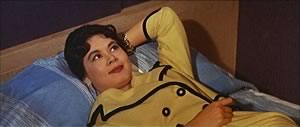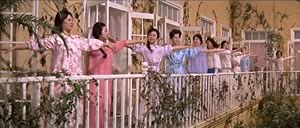1) People who know Kristin primarily as a film scholar probably don’t know that she’s also the librarian/curator of the P. G. Wodehouse papers. Every couple of years she goes to England to organize and preserve the papers that the family has acquired since her last visit. She first worked with the papers when she wrote her book on Wodehouse, Bertie Proposes, Jeeves Disposes; or, Le Mot Juste, an appreciation of the inimitable Wooster novels. For the last few days Kristin has been there working on the collection, and out of the range of the Internet; so no new entries from her. When she returns, expect a followup on her “How to read the box-office figures” post.
2) During her absence I’ve been busy with research projects. One involves scene transitions in Hollywood movies. When Kristin, Janet Staiger, and I were working on the book, The Classical Hollywood Cinema, I got interested in how movies moved the viewer smoothly from one scene to the next. Often, we found, a line of dialogue, a sound, or an image at the very end of Scene A somehow linked to Scene B. We called these “hooks,” and talked a little about them in the book.
Recently I got curious about the problem again and as I was thinking about it, I saw a piece by Karl Iglesias, called “8 Ways to Hook the Reader,” Creative Screenwriting 13, 4 (2006), 48-49. (It doesn’t seem to be available online.) Igelesias spells out various ways in which screenwriters tie scenes together. Interestingly, our term hook seems to have entered screenwriters’ parlance a little bit.
I gave a rather sketchy talk on the question here at Madison last Thursday, and got helpful feedback from faculty and grads. Seems like everybody had a good example, from Jerry Lewis movies to The Family Guy. So I hope to develop this talk into a lecture I can give elsewhere. Eventually I expect it will end as an online essay elsewhere on this site.

Les Belles

Les Belles
3) My other current research project is looking into the development of anamorphic widescreen filmmaking in Hong Kong. In the early 1960s Shaw Bros. introduced ShawScope, a system similar to CinemaScope’s sprawling format. I’m interested in how directors used this new technology, and whether they followed the same paths as Americans did in working with CinemaScope. Did ShawScope slow up their cutting or staging? Did they find alternative ways to compose for this wide format?
Despite the rather tedious plots, I’m enjoying watching the films because they’re so striking at the level of lighting and color design. If you’re curious, have a look at Les Belles (1961) or The Love Eterne (1963). Really stunning color coordination, with both saturated tones and pastels popping off the screen–so different from the murky monochrome we like now. To get such brilliant, almost shadowless imagery in a period of slow film (ASA 50!), you have to drench your sets in light. How can actors remain so chipper when they’re blasted by so much light and heat? The crew had to wear sunglasses when working on these movies. This article is for a collection of essays called Widescreen Worldwide, edited by John Belton and Sheldon Hall.
4) My old friend Brian Rose writes to tip me off to Malcolm Gladwell’s New Yorker article [1] on Epagogix, the software program that purports to predict what films will be commercial hits. This program has been flashing into view in the trade papers over the last few years, but Gladwell (aka Mr Blink) is the first to give it long and detailed discussion. I hope to assimilate it over the next few days and maybe Kristin or I will blog about it.
5.) As a new blogger, I’m still learning a lot. (Okay, you already can tell that.) But as I scan our Statistics counter for this site, I’m impressed all over again by the sheer weirdness of the Web.
Take the keywords that bring people to our site. I expect to see our names, Film Art, Scorsese, and so on. But I have to admire any search engine that can fling onto our site someone typing the following strings:
jack vermee
bonfire
lingua film di toto’
Christian film
zizek mao
Chinatown first act
and my current favorite:
where can I find photos of jerry van dyke
Of course now that I’ve listed these topics, I expect a lot of repeat business for them.